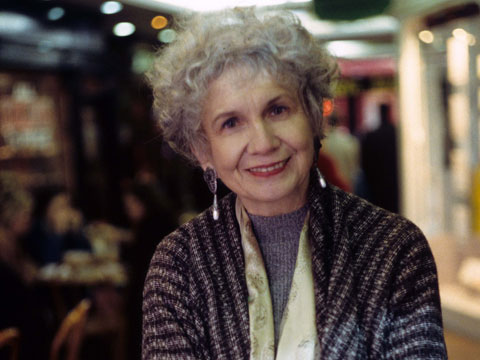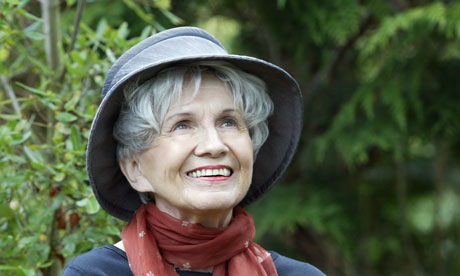There are the books we take on journeys, and the journeys we take through books. It is a long time since I’ve been to the shores of Lake Huron, Ontario; specifically to my grandparents’ cottage in Inverhuron, where we used to go every summer. I remember driving for hours through farmland, passing Amish families in buggies, seeing the water appear on the horizon, watching our dog twitch his nose and sit up as we turned down the bumpy dirt road that led to the cottage.
This is Alice Munro country, although I didn’t know it then. I discovered her stories at university, and became obsessed with Lives of Girls and Women, Something I’ve Been Meaning to Tell You, Who Do You Think You Are? – all published before I was born. Why had she not been required reading in high school, alongside other Canadian titans of letters – Margaret Atwood, Robertson Davies, Margaret Laurence? Her first collection, Dance of the Happy Shades, always takes me back to my grandparents’ cottage by the lake.
My grandmother, who was born in the 1920s, and Munro, who was born in the early 30s, grew up in nearby towns, and I sometimes imagine they shared the same experiences, the same ideas about the world. In Dance of the Happy Shades, small-town Ontario is a coded, rigid place, with expectations about what is proper for a woman to do, think and feel. The language can seem dated, the setting slightly foreign. Even Munro’s characters have old-fashioned names: Gladys, Myra, Flora. But her girls and women are wholly modern. They are passionate, jealous, clever and ambitious, oppressed by what is expected of them, and what is denied.
In the story Sunday Afternoon, a 17-year-old country girl named Alva goes to work for Mrs Gannett, an affluent lady who never fails to make it clear where Alva’s place is. “Mrs Gannett had a look of being made of entirely synthetic and superior substances,” and she struggles to maintain an imperiousness that is becoming outdated. “There was often in Alva’s tone an affected ease, a note of exaggerated carelessness and agreeability that was all the more irritating because Mrs Gannett could not think of any way to object to it.”
The narrative hinges on an alcohol-soaked summer afternoon. After lunch, the household filters out to the garden while pale Alva is left inside:
That was one of her difficulties on Sundays, when they were all drinking, and becoming relaxed and excited; she had to remember that it was not permissible for her to show a little relaxation and excitement too. Of course, she was not drinking, except out of the bottoms of glasses when they were brought back to the kitchen – and only then if it was gin, cold, and sweetened.”
I love this last detail because it captures Alva’s naughtiness and her taste for a life that is different to the one she has. She can sense there is more to existence – more fulfilment, more excitement, more adventure – and wishes that one day she will be one of the women out on the patio, drinking gin rather than trapped inside in the service of others.
She is growing up, discovering new things to desire. When Mr Gannett’s cousin – “or whoever he was” – comes into the kitchen on the pretence of delivering one last dirty glass, he holds her lightly, “as in a familiar game, and spent some time kissing her mouth”, then moves back out to the patio.
This stranger’s touch had eased her; her body was simply grateful and expectant, and she felt a lightness and confidence she had not known in this house. So there were things she had not taken into account, about herself, about them, and ways of living with them that were not so unreal.”
These early stories seem simpler to me than Munro’s later work. Her characters have aged with the author, and the pieces become longer, more complex, less about one event one Sunday afternoon and not as fixed on an ending with a twist or the kind of insight Alva has.
In Walker Brothers Country, which opens Dance of the Happy Shades, a young, unnamed girl sees a glimpse of the life that her door-to-door salesman father led before he met her mother. With her brother, they visit his old flame Nora, a spinster who has settled into a lonely middle age, taking care of her elderly mother in a secluded farmhouse. This visit by the father sparks a longing that Nora might have repressed, and the children she finds in her sitting room are evidence of the life she will not have. The girl’s understanding of what she sees pass between her father and Nora is what I find so intriguing and true. As they travel home down dusty country roads, she thinks about her father’s life “darkening and turning strange, like the landscape that has an enchantment on it, making it kindly, ordinary and familiar while you are looking at it, but changing it, once your back is turned, into something you will never know”.
My grandparents’ cottage was sold when they became too frail to drive, and I haven’t returned to Lake Huron in almost 15 years, except through these stories. In Dance of the Happy Shades, Munro takes me to the proximate past. I see flashes of myself in these characters, but the stories themselves are a journey to my grandparents’ time. They make me think of dusty roads and rural life, of a place that is very familiar but just out of reach – and of sweetened gin in the bottom of a glass on a summer afternoon.











